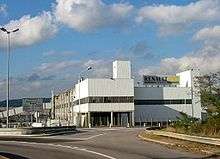Société de Véhicules Automobiles de Batilly
| Subsidiary | |
| Industry | Automotive |
| Founded | 1 July 1980 |
| Headquarters | Batilly, France |
Key people | Pascal Felten (Director) |
| Products | Master III |
Production output | 92,811 (2013)[1] |
| Parent | Renault |
| Website | sobav.com |
| Built | 1979 |
|---|---|
| Coordinates | 49°10′24″N 5°58′42″E / 49.173306°N 5.978394°ECoordinates: 49°10′24″N 5°58′42″E / 49.173306°N 5.978394°E |
| Employees | 2,371 (end 2013)[2] |
| Area | 101 hectares |
| Address | SOVAB Batilly, Zone industrielle, BP 2, 54980 Batilly, France |
The Société de Véhicules Automobiles de Batilly (French pronunciation: [sɔsjete də vɛikyl otɔmɔbil də batiji]) (SoVAB) is a subsidiary of the French car manufacturer Renault, created in 1980 to operate the light commercial vehicle plant located at Batilly.[3]
History
The project to create a new facility at Batilly was begun by Renault's subsidiary Saviem in 1972. It was continued when Saviem was merged with Berliet to form Renault Véhicules Industriels (RVI).[4] The factory was constructed between 1976[5] and 1979. In 1980 Renault took from its subsidiary RVI a 25% stake of the factory's capital to form SoVAB. At the same year the factory started to manufacture the first-generation Master.[6] The first-generation Trafic was introduced in 1981 and the Renault B in 1982.[4] During the following years Renault collaborated with General Motors and in 1997,[7] they launched the Master II which was also marketed as Opel Movano. From 1995 onwards the Batilly factory became the sole assembler of the Trafic I, after the Chausson's Creil factory was closed down.[8] The model was discontinued in 2000. Renault kept Batilly when sold RVI to Volvo in 2001. In 2010 was introduced the Master III.[3]
Facilities
The SoVAB complex comprises 101 hectares of which 181,838 m2 are covered. There is a single production line. The vehicles assembled by the company are sold by Renault, Opel/Vauxhall, Nissan and Renault Trucks. On 13 June 2013, SoVAB produced its 2,000,000th unit.[9]
Whithin Sovab there is also a Renault Tech workshop which has 6,800 m2 and employs 72 people.[10]
Vehicles manufactured

- Renault B/Messenger (1982−?)
- Renault Master I (1980−1997)
- Renault Master II/Mascott (1997−2010)
- Renault Master III (2010−present)
- Renault Traffic I (1981−2000)
References
- ↑ "2013 Registration Document" (PDF). Renault. p. 14. Archived from the original (PDF) on 8 April 2014. Retrieved 8 April 2014.
- ↑ "Chiffres-clés" [Key numbers] (in French). SoVAB. Retrieved 24 April 2013.
- 1 2 "Batilly factory". Renault. Archived from the original on 9 April 2014. Retrieved 6 October 2016.
- 1 2 "Historique SoVAB" [SoVAB History] (PDF) (in French). Sudautomobile-sovab.fr. Archived (PDF) from the original on 29 August 2014. Retrieved 9 April 2013.
- ↑ Tipler, Jhon (1999). Trucks. Chartwell Books. p. 122. ISBN 978-0-785-81090-2.
- ↑ "Filières et développement économique" [Sectors and economic development] (in French). Insee (Institut national de la statistique et des études économiques). Retrieved 9 April 2013.
- ↑ World Automotive Industry Trends. 1997 Yearbook. WAIT. 1997. p. 110.
- ↑ "Deux générations de véhicules sur une ligne" [Two generations of vehicles on one line] (in French). L'Usine nouvelle. 23 November 1995. Archived from the original on 29 August 2014. Retrieved 29 August 2014.
- ↑ "Véhicules utilitaires légers : Groupe Renault : 2.000.000 d'unités produites par la SoVAB" [Light commercial vehicles: Renault group: 2,000,000 units produced by SoVAB] (in French). Automania.be. 14 June 2013. Retrieved 29 November 2014.
- ↑ "Lorraine. Sovab - Renault Tech : Le véhicule utilitaire haute couture" [Lorraine. Sovab - Renault Tech: The high fashion utility vehicle] (in French). Le Journal des Enterprises. 6 December 2013. Archived from the original on 14 December 2013. Retrieved 29 November 2014.

